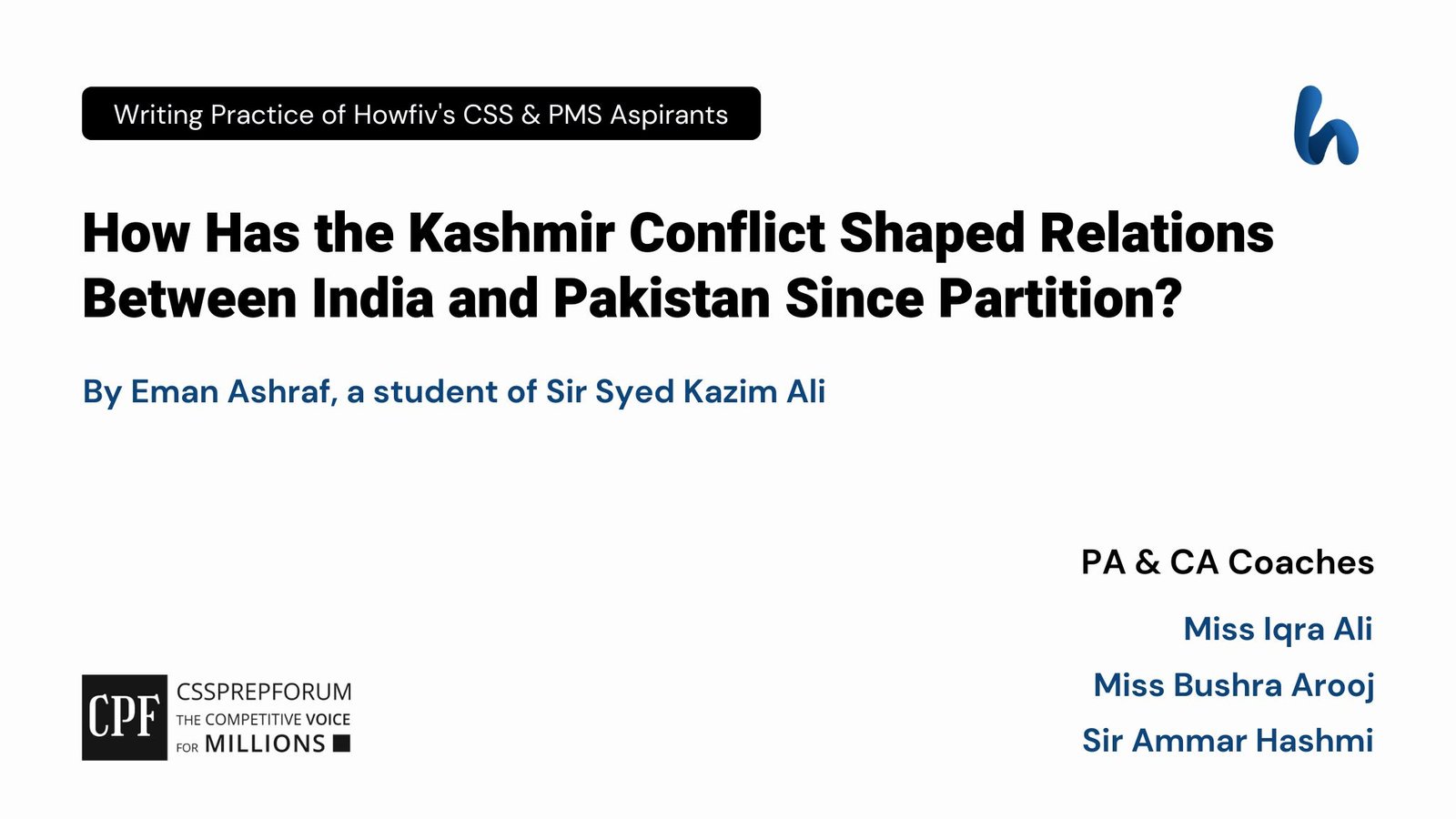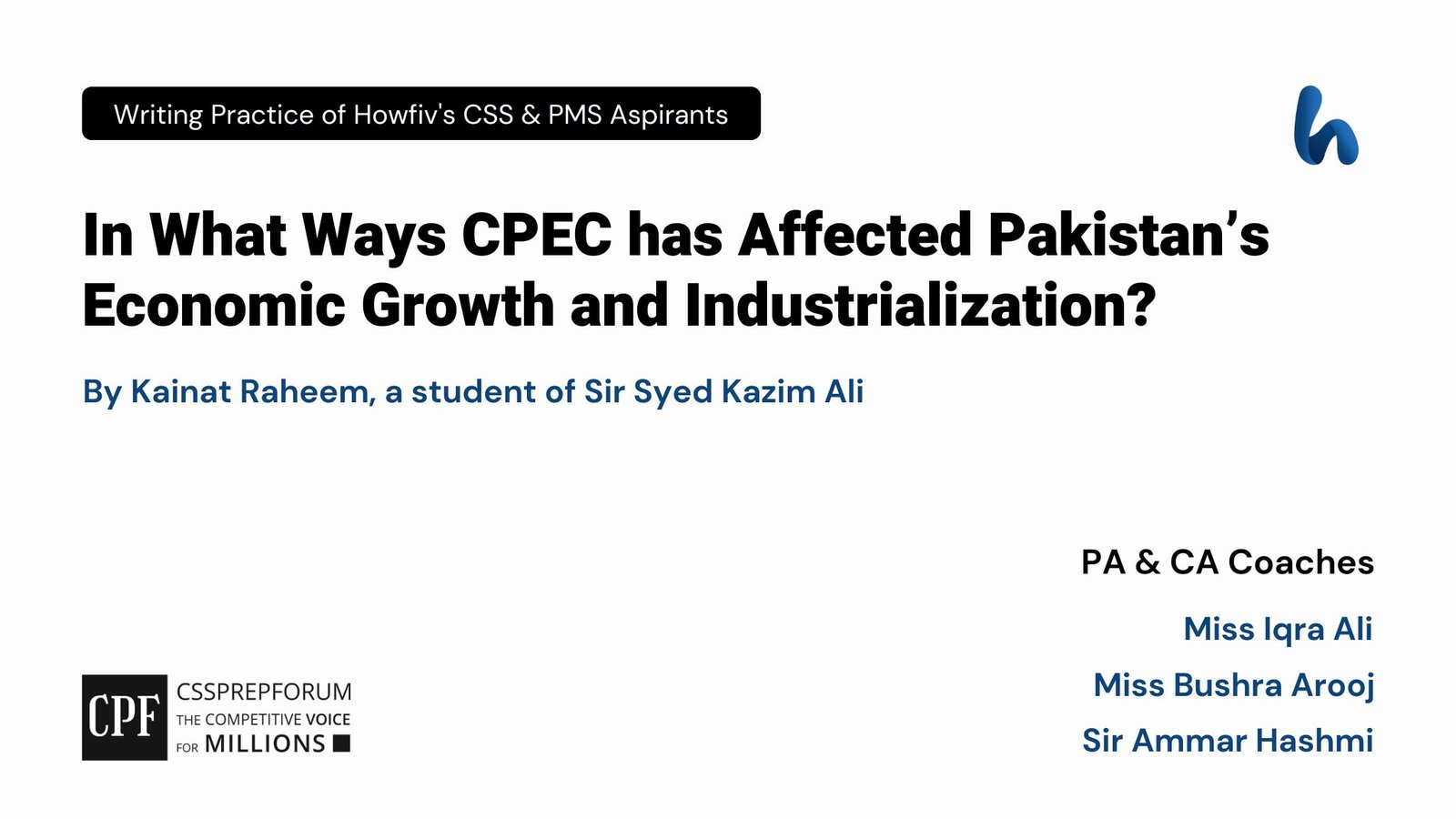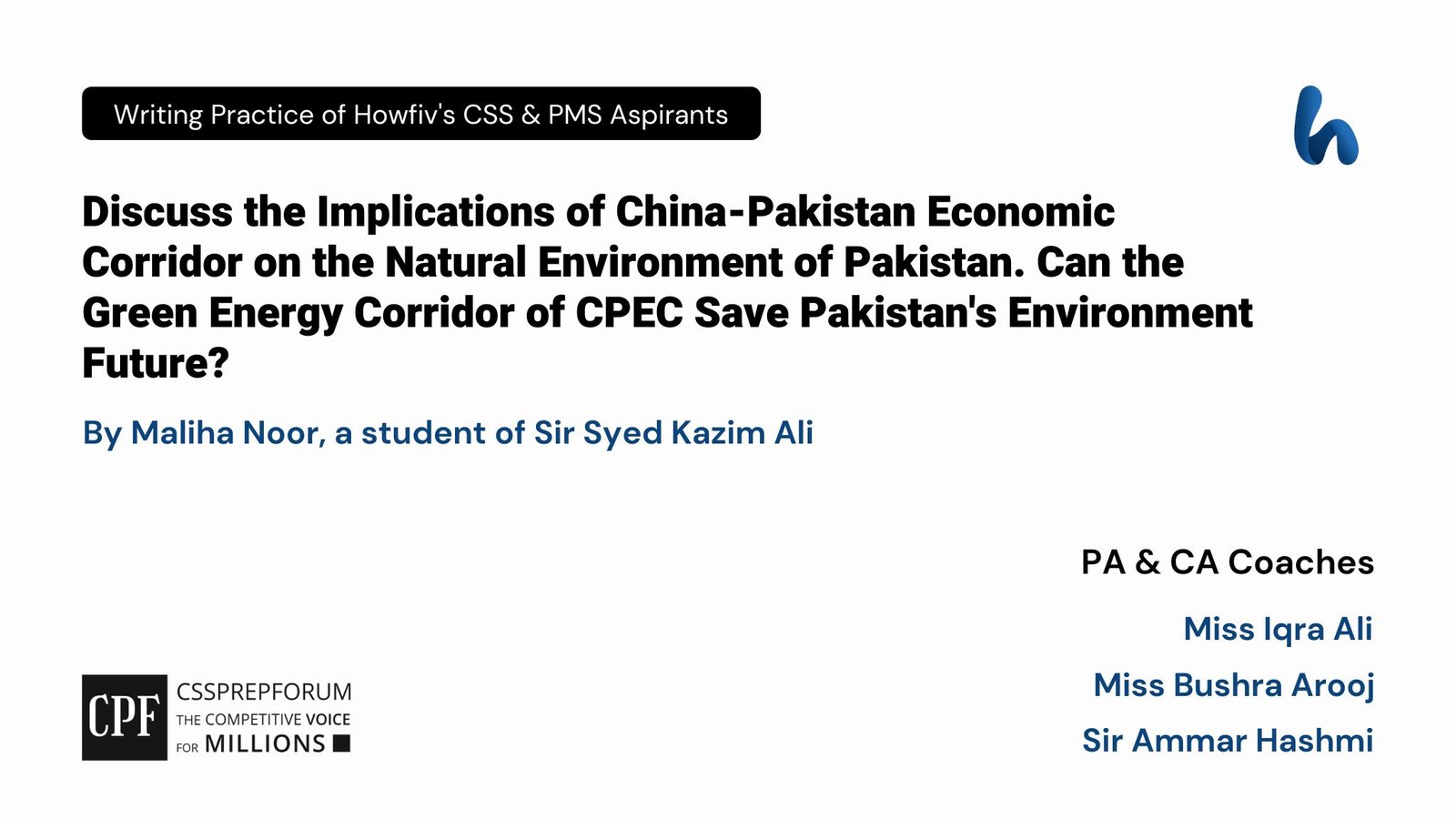Measures to Improve Pakistan’s Economy | DailyWriteups | Opinions
The following article, “What Measures Do You Suggest to Improve the Economy of Pakistan, Particularly in the Areas of Debt Reduction and Enhancing Export Capacity?”, is written by Quratulain Babar, a student of Sir Syed Kazim Ali. Moreover, the article is written on the same pattern, taught by Sir to his students, scoring the highest marks in compulsory subjects for years. Sir Kazim has uploaded his students’ solved past paper questions so other thousands of aspirants can understand how to crack a topic or question, how to write relevantly, what coherence is, and how to include and connect ideas, opinions, and suggestions to score the maximum.

Outine
1-Introduction
2-Economic Profile of Pakistan
3-Current Situation of Pakistan’s Economy
4-Causes of the Economic Crisis of Pakistan
- ✓Lag in the technological advancement
- ✓Energy crisis in the country
- ✓Increasing fiscal deficit
5-Ways to Improve Pakistan’s Economy, Particularly Debt Reduction and the Enhancement of Export Capacity
- ✓By emphasizing export-led growth
- An overhaul of export policies
- The advancement of textile and other emerging exports
- The prioritization of the agriculture sector
- ✓By managing debt and deficits
- Better debt management
- Handling of fiscal deficits
- Expenditure front
- Revenue front
- The reconsideration of power sector policies
6-Critical Analysis
7-Conclusion

Answer to the Question
Introduction
Pakistan has suffered from a backbreaking economic crisis and is currently going through a financial crisis. The country is on the brink of economic catastrophe due to low growth rates, high levels of debt, chronic fiscal deficits, skyrocketing inflation, low productivity, and widespread poverty. The crisis warrants urgent and sustained attention and can only be resolved if specific, pragmatic measures are taken. For instance, by emphasizing export-led growth, managing debt and deficits, revamping the power sector, and prioritizing the agriculture sector, most of the economic perils the country is facing can be averted. Thus, the political elite should get out of their hibernation and concentrate on the country’s economic governance, as there is no alternative solution.
Economic Profile of Pakistan
Pakistan’s economy is classified as a developing economy, and it is the 24th largest in terms of GDP based on purchasing power parity and the 46th largest in terms of nominal GDP. The economy is primarily agrarian, where agricultural contribution to GDP is 21%, providing employment opportunities for 44% of the labour force. Another significant economic sector is industry, primarily cotton textile, which accounts for 4% of the GDP and employs almost 40% of the country’s labour force. Moreover, the services sector – the fastest-growing sector of the economy – accounts for 54% of the GDP and a little over one-third of total employment.
Current Situation of Pakistan’s Economy
Currently, Pakistan is at a critical juncture as the country is facing the worst economic meltdown in its history. For instance, internal and external financial imbalances remain wide, and foreign exchange reserves are fragile despite the injections of funds from the International Monetary Fund (IMF) and friendly countries. Besides this, there are many other factors depicting the gloomy situation of the country, such as inflation at its peak; domestic and foreign debt reached unsustainable levels; the rupee that has lost its value against the dollar; fallen exports; declined overseas remittances, and the lowest Foreign Direct Investment (FDI) ever experienced. Further, Moody’s blistering statement in a speech against Pakistan due to which its credit rating has been downgraded, “The country has zero ability to afford its own debt, so it is considered one of the weakest among the sovereigns that the rating agency deals with,” is also the testament of the country’s deplorable state. Thus, the government is grappling with the most severe economic crisis.
Causes of the Economic Crisis of Pakistan
Further, this issue finds its roots in many causes.
- Lag in Technological Advancement
First, the lag in technological advancement is the primary reason for the economic crisis; all the major sectors of the economy have outdated machinery – be it agriculture or industry. For example, Pakistan’s textile industry lost its relatively more prominent position in the 1960s and 1970s, sharing 11% of the world’s cotton textile market, and today holds a little less than 2% of the world market. To illustrate, while Pakistan is one of the world’s largest cotton producers, it loses this advantage due to poor picking, ginning, and elimination of contamination. In terms of weaving, Pakistan is one of the largest exporters of woven clothes, although much of the woven fabric is of low value, which is attributed to the low level of technology. Thus, lagging technological advancement is impeding the economy’s growth.
- The energy crisis of the Country
Further, the ongoing energy crisis has crippled Pakistan’s industry and economy. It is hitting the industry at multiple levels: energy tariff increases are forcing businesses with low margins to close; unannounced load-shedding and voltage fluctuations damage machinery worth millions of dollars; unavailability of electricity harms the workforce’s productivity. Apart from industry, the over-dependence on petroleum products has dented the economy, creating unsustainable circular debt. To the National Electric Power Regulatory Authority, almost 63% of the total electricity production is now oil-based, which has burdened the country due to the increase in oil prices. The perfect illustration of this can be seen in the burgeoning rise in power tariffs. Hence, the energy crisis has burdened the national exchequer, creating less room for other government expenses.
- Increasing fiscal deficits
Another culprit of the economic crisis is the fiscal deficit. According to the World Bank’s Pakistan Federal Public Expenditure Review, the country’s fiscal deficit, averaging 6.2pc of GDP during the last decade, has been one of the main reasons behind the nation’s rapidly burgeoning public debt and growing trade gap. On the revenue side, the government has a flawed taxation policy due to tax exemptions and evasions. On the expenditure end, most of the national exchequer is contributed to debt servicing and current expenditure, and the developmental projects receive the smallest chunk of the government resources. Hence, increasing deficits are a significant challenge to economic growth.
Ways to Improve Pakistan’s Economy, particularly Debt Reduction and the Enhancement of Export Capacity
However, the economic crisis the country is facing needs specific policy measures to be averted. These measures are discussed below, mainly concerning the remedies to contain the increasing debt and improve the country’s exports, ultimately leading to improved economic growth.
A- By emphasizing export-led growth
- ✓An overhaul of export policies
First, there is a need for a comprehensive review of the country’s export policies as the current account deficit (CAD) has risen to 4.6% of the GDP. In this regard, specific lessons can be learnt from neighbouring countries, such as India, Bangladesh, and Thailand. To illustrate, these countries offer incentives to the exporters, for example, concessional export finance, full export insurance, and, among others, export cash incentives. In terms of export cash incentive, the classic example is that of Bangladesh, which provides 2 to 20 per cent of export cash incentive on the export price of 24 export products. Clearly, Pakistan needs to learn from the success of these countries and revamp its export policies if it is to stand out in the competitive global environment.
- ✓The advancement of textile and other emerging exports
In addition to export policies, more research and development are required in the textile sector, along with capital-intensive technology. For example, in the industrial sector, there is a need to invest in the dyeing side of the industry rather than printing, which will result in the unit price of the fabric being exported. Also, more diversification in the value-added segment is required if the country wants to compete globally, as it shares less than 1% of the global apparel market. Further, there is a dire need to provide strong incentives and prepare an export development plan for emerging and nascent export items. In this consideration, Hafiz Pasha recommends specific measures. For instance, the Ministry of Commerce and the Pakistan Trade Development Authority should identify the principal constraints to the growth of emerging and nascent exports in collaboration with an international multilateral agency like the World Bank. The steps and projects necessary for removing the limitations should be implemented on a priority basis. Moreover, the ten emerging or nascent manufactured goods should be declared as zero-rated industries and should not be subjected to domestic sales tax. These steps would help in the enhancement of the export capacity.
- ✓The prioritization of agriculture
Besides, the agriculture sector should be prioritized as it is the backbone of the economy. To illustrate, almost 45 per cent of the manufacturing sector is agro-based, and 46 per cent of the economy is directly or indirectly dependent on the agriculture sector. So, it is necessary to strengthen the industry, for which specific measures can be considered. For instance, the average import duty on agricultural imports, except primary food pulses and wheat, should be increased to an average of 20%, promoting domestic agriculture. Further, the rise in procurement prices must keep pace with input costs. Moreover, there is a need to introduce a cross-subsidy for fertilizers, resulting in a decline in input costs. These steps will improve the growth of the agriculture sector, eventually leading to the development of the economy and exports.
B- By managing Debt and Deficits
- ✓Better debt management
Moreover, the issues related to the country’s domestic debt need to be addressed as external debt inflows are primarily determined by donors and lending agencies, which are drying up due to declining credit-rating problems. For this purpose, it is pertinent to understand the country’s source of debt. It has shifted from short-term market treasury bills to long-term Pakistan Investment Bills, resulting in increased interest rates. To manage the debt, it is suggested that the government should opt for unfunded debt, the primary source of which is the National Saving Schemes. These instruments directly access the savings of households; therefore, they not only lead to higher savings rates but also imply the less inflationary implications of financing the budget deficit. These measures will alleviate the country’s burden of heavy interest rates on long-term debts.
- ✓Handling of fiscal deficit
Besides, if the debt burden is to be considered, the fiscal deficit forms an integral part of the question as most of the debt is taken to fill the financing gaps. And to address the fiscal deficit, the government’s expenditure and revenue collection are essential, which are discussed below.
- Expenditure Front
As far as government spending is concerned, it should be productive. To re-emphasize the point, S. Akbar Zaidi argues that it is not borrowing as such which is the problem, but the use of borrowed money. The problem, then, is not to tell the government to reduce its spending, as the IMF insists all governments should do at all times, but what is imperative is that government expenditure be productive. For this purpose, the essential and minimum requirement is the need to hold government accountable for spending productively. This initiative will encourage Pakistanis to pay taxes as the main reason behind tax evasion is that the masses feel cheated by the government in that they feel that their contribution to the exchequer is being squandered away. - Revenue Front
On the revenue collection side, the taxation system should be revamped. Suppose the government is serious about tackling the tax collection issue. In that case, it must consider the Federal Board of Revenue as an essential state institution by appointing the right people for the right job, with well-defined career-oriented expertise in the organizational hierarchy. Tax collection can further be improved by taking revenue-enhancing measures; for example, all large property transactions should be registered only after verifying the buyer and purchaser’s national tax number (NTN). Furthermore, there is a need to make the tax laws equitable by bringing all politicians into the tax net and taxing agricultural income. Hence, these measures will increase revenue collection.
- ✓The reconsideration of the power sector policies
Another central area of concern is the power sector, which has indeed emerged as the black hole of the national economy. For example, it received a subsidy of Rs. 1100 billion in 2021-2022, and the government had to cover contingent liabilities of the sector of Rs. 330 billion, let alone fuel costs that have increased enormously. To counter this jeopardy, Hafiz Pasha suggests some remedial measures. To illustrate, privatization and provincialization of the distribution companies (DISCOS) can be explored. Moreover, handling back power distribution to the Water and Power Distribution and Regulatory Authority (WAPDA) may be considered, facilitating power sector vertical integration. These measures will increase the efficiency of the power sector and reduce the burden of its losses on the national exchequer, creating more fiscal space.
Critical Analysis
To critically evaluate the remedial measures to avert the country’s economic crisis, it is a robust civil society that can push the government to carry reforms as whatever mess Pakistan’s economy finds itself in is mainly due to the political elite’s inability. For example, governments do not touch controversial issues such as agricultural income tax and military spending to ensure their extended survival. Instead, they rush to the IMF for financial assistance, continuing to delay the day of reckoning. They acquire loans to meet their revenue gap so that unpleasant measures can be avoided. Thus, to clear the mess, popular pressure should be directed towards demanding reforms that will improve the economy’s structure so that there is no need to borrow under harsh conditions. Further, whether it be agricultural income tax or land reforms, military spending or development expenditure, the government should be forced by public opinion and public pressure to undertake the extensive reforms that are long overdue.
Conclusion
To cut a long story short, for the country to escape its self-inflicted calamity that has swallowed the economic growth, the pillars of the state need to take hard-headed measures to pull the country out of this quagmire. These measures include the management of budgetary constraints, improvement in the governance of the power sector, and policies to incentivize exports. These measures would help the country manage its debts and improve its earnings through exports, creating more fiscal space for the government to breathe in.

CSS Solved Past Papers’ Essays
Looking for the last ten years of CSS and PMS Solved Essays and want to know how Sir Kazim’s students write and score the highest marks in the essays’ papers? Then, click on the CSS Solved Essays to start reading them.
CSS Solved Essays
CSS Solved General Science & Ability Past Papers
Want to read the last ten years’ General Science & Ability Solved Past Papers to learn how to attempt them and to score high? Let’s click on the link below to read them all freely. All past papers have been solved by Pakistan’s top CSS GSA coach having the highest score of their students.
General Science & Ability Solved Past Papers












